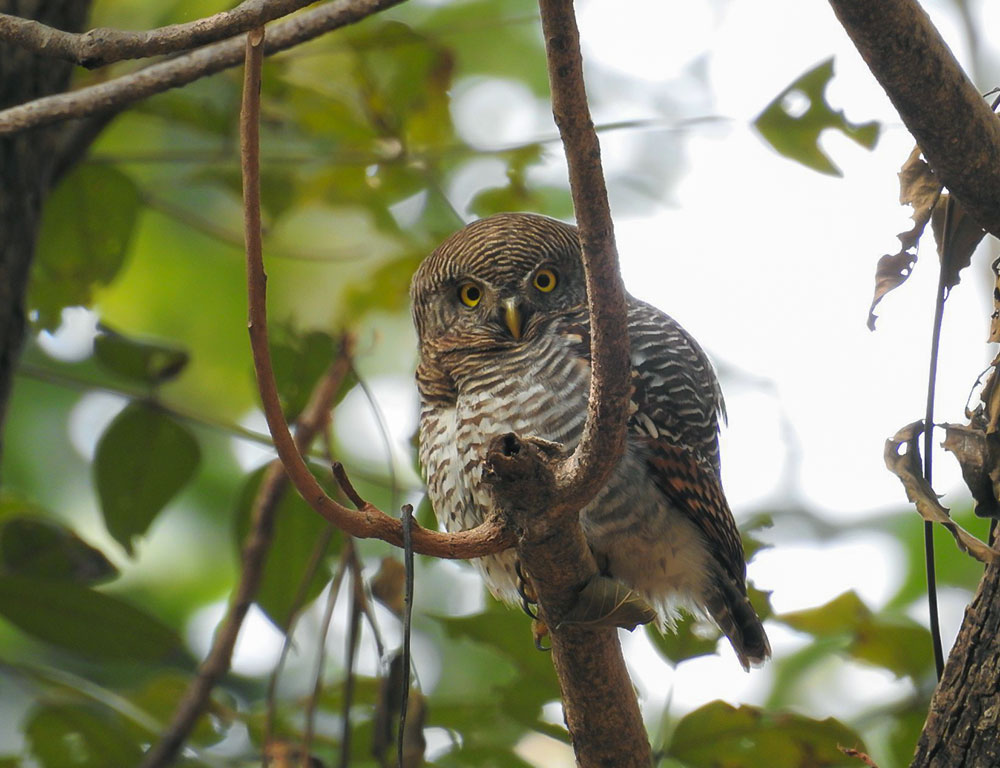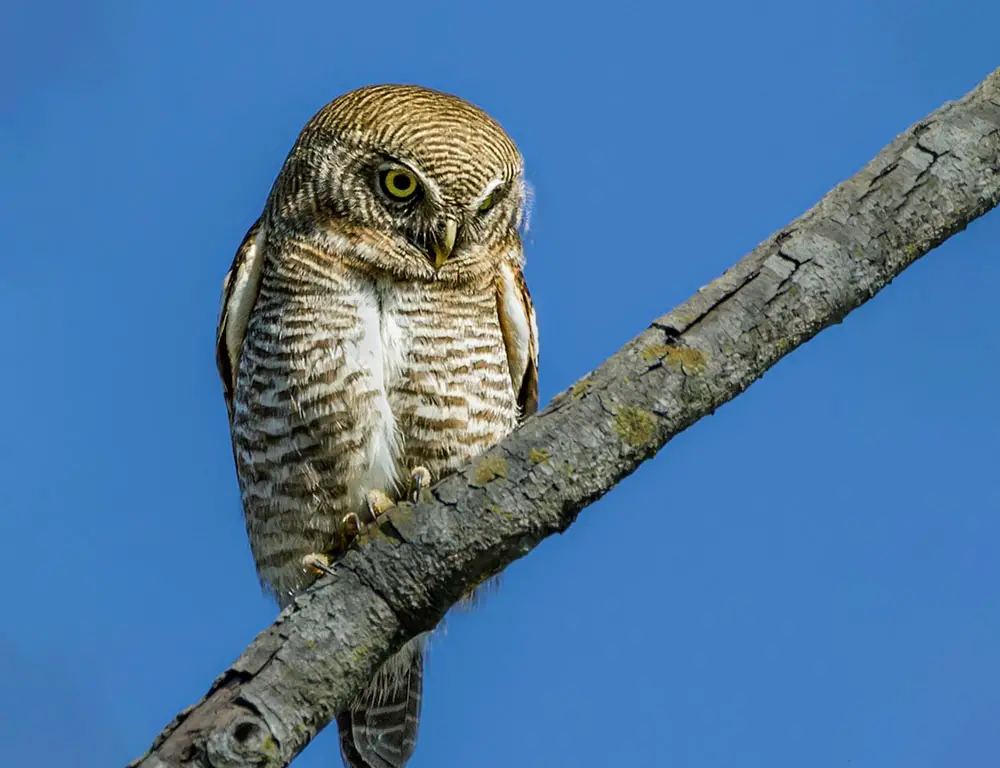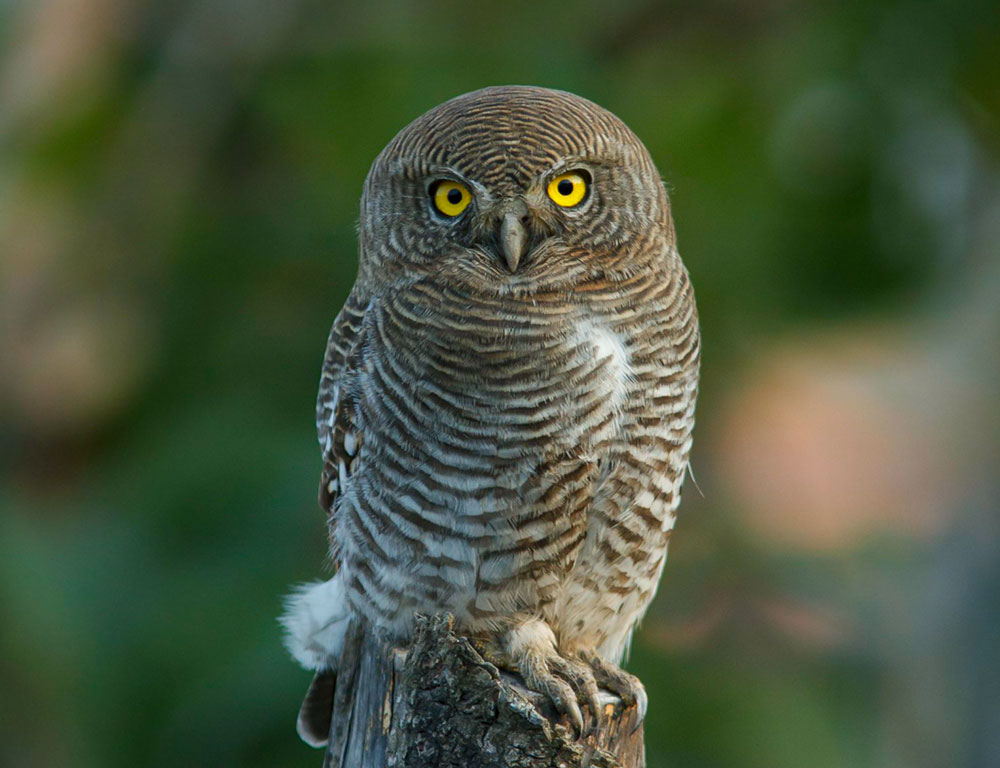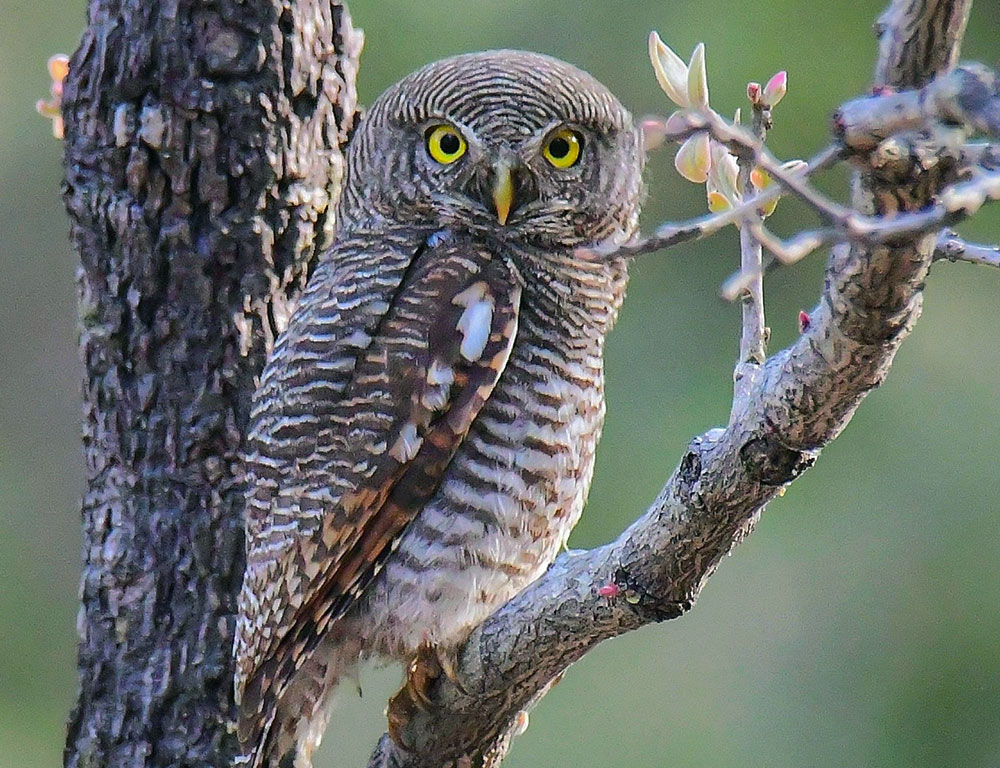I’m here to unravel the mysteries of the Jungle Owlet, a fascinating bird that calls India’s thick, verdant jungles home. This small owl species, known scientifically as Glaucidium radiatum, is an absolute delight for bird watchers and nature enthusiasts.
Its compact size, stellar hunting skills, and unique vocalizations are just a few intriguing facets that make it worth exploring.
Hidden within their charmingly speckled plumage lies a world of avian wonders. Jungle Owlets lead primarily solitary lives, but their presence in our ecosystem is far from insignificant.
They play an essential role in maintaining the balance by controlling populations of rodents and insects – their primary prey.
Now, let’s dive deeper into understanding this remarkable creature’s lifestyle, habitat preferences, breeding habits, and more.
With every fact we uncover about the Jungle Owlet’s life cycle or diet patterns, we’ll realize how vital it is to protect these precious birds and their natural habitats from destruction or degradation.
Habitat and Distribution of the Jungle Owlet

The Jungle Owlet, with its charming character and distinctive appearance, inhabits the dense jungles of the Indian subcontinent, primarily found in India, Sri Lanka, and Nepal.
Here’s a closer look at their habitat and distribution:
Geographical Range
- India: Jungle Owlets are widespread across various regions of India.
- Sri Lanka: They are common inhabitants of Sri Lanka.
- Nepal: While slightly less frequent compared to India and Sri Lanka, Jungle Owlets can still be found in Nepal.
Altitude and Habitat
- Jungle Owlets exhibit a wide altitude range, inhabiting areas from sea level to approximately 1500 meters high.
- They display remarkable adaptability in their choice of habitats, thriving in diverse environments such as deciduous forests, evergreen woods, plantations, and even gardens. This versatility allows them to make themselves at home in various locales.
Nesting Behavior
One of the most fascinating aspects of Jungle Owlets is their nesting behavior. Instead of constructing their nests, they repurpose those abandoned by other species, such as woodpeckers or barbets.
This resourceful nesting strategy allows them to use existing structures, demonstrating their adaptability and survival instincts.
Physical Characteristics of the Jungle Owlet

The Jungle Owlet, a captivating species of owl, boasts a set of distinctive physical characteristics that aid its survival and make it a fascinating subject of study. Let’s delve into its physical traits:
Size
Typically measuring 20 to 21 cm, the Jungle Owlet is slightly larger than a sparrow, making it surprisingly compact for an owl species.
Plumage
Adorned in a mottled grey-brown plumage, with white markings on the eyebrows and throat, the Jungle Owlet sports a unique pattern that helps it blend seamlessly into its wooded habitat. Its wings and tail are banded with white streaks, further aiding in camouflage.
Eyes
One of the most striking features of the Jungle Owlet is its large, bright amber eyes. These eyes contribute to its adorable appearance and enhance its night vision capabilities, which are crucial for hunting in low-light conditions.
Beak
The Jungle Owlet’s beak is hooked and sharp, perfectly adapted for tearing apart prey. Its color can vary from light yellow to greenish-gray, providing a contrast against its dark, feathered face.
Legs
The legs of the Jungle Owlet are feathered to the toes, giving them an almost fluffy appearance. Beyond aesthetics, this plumage likely provides additional insulation, particularly in cold weather.
Vital Stats
- Length: 20-21 cm
- Wingspan: 58-61 cm
- Weight: 98-105 g
Behavior and Diet of the Jungle Owlet

The behavior and diet of the Jungle Owlet, a small but fascinating bird native to the dense forests of India, offer insights into its adaptation and survival strategies:
Activity Patterns
The Jungle Owlet is primarily crepuscular, meaning it is most active during the twilight hours at dawn and dusk. During these times, it engages in hunting activities and other behaviors essential for survival.
Sunbathing
The Jungle Owlet’s habit of sunbathing in the early morning light is interesting. It spreads its wings and tail feathers to soak up the warmth, which could help regulate its body temperature and maintain optimal health.
Hunting Behavior
The Jungle Owlet is a swift and efficient predator despite its small size. It hunts alone, relying on its keen senses and silent flight to capture prey. This bird demonstrates remarkable agility and precision during hunting expeditions.
Diet
The Jungle Owlet is primarily insectivorous, feeding on a diverse array of insects such as beetles and moths. However, it is also known to opportunistically prey on small mammals and reptiles when the opportunity arises. This dietary flexibility allows the Jungle Owlet to exploit various food sources within its habitat.
Social Behavior
While not typically social birds, Jungle Owlets exhibit more social behaviors during mating season. Pairs can be observed engaging in activities such as mutual preening and sharing food, displaying affectionate gestures towards each other.
Jungle Owlet Conservation Status

The conservation status of the Jungle Owlet, as classified by the International Union for Conservation of Nature (IUCN), is “Least Concern.” This categorization indicates that the species is not currently facing significant threats to its survival.
However, it’s essential to note that this status doesn’t imply complete safety or the absence of concerns.
Despite being classified as “Least Concern,” Jungle Owlets still face various challenges that could impact their populations:
Habitat Loss
Deforestation and habitat degradation due to human activities, such as logging, agriculture, and urbanization, threaten the Jungle Owlet’s habitat.
Loss of suitable habitat can lead to fragmentation and isolation of populations, affecting their long-term viability.
Hunting and Trapping
While not as significant as habitat loss, hunting and trapping for food, traditional medicine, or illegal wildlife trade can still impact Jungle Owlet populations, especially in certain regions where such activities occur.
Climate Change
Climate change can alter habitat conditions, affecting prey availability, nesting sites, and overall ecosystem dynamics. Extreme weather events, shifts in precipitation patterns, and temperature changes can all impact the Jungle Owlet’s habitat and food sources.
Human Disturbance
Human activities, such as recreational activities, tourism, and infrastructure development, can disturb nesting sites, disrupt feeding behavior, and cause stress to Jungle Owlets, particularly in areas frequented by humans.
Here’s a quick look at some figures:
| Year | Category |
|---|---|
| 2004 | Least Concern |
| 2022 | Not Evaluated |
Conclusion
I’ve thoroughly enjoyed deep diving into the world of the Jungle Owlet. It’s been fascinating to learn about this unique bird, from its nocturnal habits to its diverse diet. I hope you’ve found it as captivating as I have.
In our journey, we discovered that these owlets are primarily found in India and Sri Lanka. We also understood their preference for deciduous forests over dense jungles or desert environments. Each fact contributes to the complex puzzle that is the life of a Jungle Owlet.
We also examined their diet and feeding habits, learning they’re not picky eaters! From insects to small mammals, these owlets feast on various foods. This adaptability indeed contributes to their survival in multiple habitats.
Lastly, we explored how these birds communicate using distinct calls that can be heard during dusk and dawn – nature’s symphony!
Let’s take a moment now to recap some key facts:
- Primary habitat: India and Sri Lanka
- Preferred environment: Deciduous forests
- Diet: Insects, small mammals
- Communication: Unique vocalizations
To sum it up, getting acquainted with the Jungle Owlet has been an enlightening experience. It’s reminded me once again of nature’s endless wonders and diversity. Here’s hoping this exploration sparks your curiosity, too – there’s always more to discover in our natural world.